|
Gracie Jiu-Jitsu History.
|
|
|
Mitsuo Maeda |
Jigoro Kano |
Jigoro Kano |
History of Brazilian ju-jitsu starts with a Japanese fighter, master of jujutsu and Kodokan Judo Mitsuo Maeda (Count Koma-count of battle). Maeda (1878 - 1941 G.) was born in the small town of Aomori in northern Honshu. At the age of eight he moved to the capital. Maeda studied at the elite school Hirosaki, where he was known as "child - sumoists". Such a nickname he received because of their passion for the art of combat, that his father taught at that time. Later, Maeda went to the university, which today is called Waseda, and is known as a major training center. It was there that he learned techniques of classical jujutsu. At the age of 18, Maeda starts training at the Kodokan (the House of the Study of the Way). The founder of Kodokan Jigoro Kano (September 28, 1860 - May 4, 1938) Master Keator, Shinya Tenjin-Ryu, as well as basing on other schools of jujitsu in 1882, created judo (soft, flexible way). Maeda's height was about 168 cm (5 feet 6 inches), weight 70 kg (150 pounds), he consistently trained and after two years received 1 st dan. In 1901, Maeda received the third dan (degree) as an instructor of judo in the universities of Tokyo, Waseda, Gakushin.
In 1904 Jigoro Kano assigns Maeda his 4th dan and together with the Tomita Tsunedziroy (7th dan) sends them to the U.S.. A year earlier, the American industrialist Samuel Hill suggested Yamas Yoshiaki (1875-1935) to travel to the U.S. to teach his son judo. Yamashita received the proposal, but, unfortunately, arrived in the United States, learned that their contract is terminated because of the intransigence of Mrs. Hill, speaking strongly against teaching her son the art of Japanese combat. But Hill managed to arrange for another place for Yamashita, as well as the meeting at the White House with the U.S. President Theodore Roosevelt, who after reading the book Inadzo Nitobe (1862-1933) "Bushido - the soul of Japan" became interested in samurai culture and martial arts. Yamashita's height was 162.5 cm and weight - 68 kg, however, he successfully fought against american fighter twice his size, which made a huge impression on Roosevelt, and he personally assisted in getting Yamashita a judo instructor position at the Naval Academy with a salary of U.S. $5000, which at that time was truly the royal salary. In parallel, Yamashita's wife taught judo for ladies of high society. The couple spent two years in the United States. Less successful was the visit Tsunedziro Tomita and Maeda.
Roosevelt wanted to have another instructor of judo in Washington, as Yamashita taught elsewhere. Kano recommended his first disciple, refined and educated man, who spoke English. But at his level of wrestling Tomita was much inferior to the other stars of Kodokan, so Tomita also took one of the strongest fighters - Maeda. For Tomita the intension was to explain the theory of Judo, and for Maeda - to demonstrate its effectiveness in combat. This plan worked successfully during a demonstration at West Point, where Maeda first resisted attacks of the professional player in American football, and then a boxer. But in Washington, things changed. After Tomita and Maeda had a formal demonstration of Kodokan Judo, one of the present players challenged Tomita personally. The result of the fight for the latter has been disappointing: he failed to throw, and he immediately proved to be flattened to the floor of the body weight of the American. President Roosevelt diplomatically tried to hush up the incident, denying further competition on the pretext that Tomita, was apparently badly affected by the climate change, and invited the Japanese to the gala dinner at the White House. After that, Tomita returned to Japan, and Maeda eager to restore the reputation of jiu-jitsu stayed in America. He fought a thousand fights and never lost a battle with no rules or rules of judo and lost only twice in battles with professional wrestlers at their rules. Maeda, even challenged the champion heavyweight Jack Johnson, whom many called the best boxer of our time. Thus, the Japanese established a tradition, which in consequence the Gracies will follow: to challenge the reigning champion in boxing (Joe Luys vs. Helio, and Rickson vs. Mike Tyson). Boxers also have created a tradition - never take on such calls. After his tour of North America, Maeda traveled to Central and South parts, and later visited Europe. He fought in many professional fights, and, thus, violated many moral precepts of judo, which were quite strict. Perhaps that is why Maeda called his art of jiu-jitsu, not judo. When he began to fight as a professional fighter, Maeda has often been forced to use techniques that were banned in judo, but allowed in the former part of the previously studied jiu-jitsu. In addition, Maeda was an intelligent and observant innovator. He added to his arsenal of new techniques and cleaned those deemed to be not effective. He developed his own style, purpose of which was successfully challenged by two main types of fighters in the West - the wrstlers and boxers. In matters of technology, he walked away from pure judo. By educating people, whom he met in his travels, Maeda insisted that they called his style jiu-jitsu. Stunning achievements have made him a legend in Central and South America. In early 1920 Maeda returned to Brazil and became the focus of feverish activity, initiated by the Japanese government to establish a colony in the northern part of the country. The project was quite difficult to implement (in fact, it immediately fell through). The only Brazilian, who used his political connections to help Maeda, was Gustav Gracie; his family emigrated to Brazil from Scotland. The friendship which grew between the two men led to the fact that Maeda agreed to teach the eldest son of Gustav, Carlos (1902, 1994).
Gracie Family History.
In 1801, George Gracie came to Brazil from Scotland. One of George's grandons - Gustav Gracie - was an educated diplomat. He studied German, and was fluent in seven languages. Gustav, however, he decided to abandon the diplomatic career and instead went into business. At that time Gustav lived in Bila, state of Pará in the delta of the Amazon. Gustav had eight children, five of whom were boys.
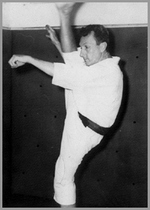
Carlos Gracie
|
Carlos (names of others Osvaldo, Gustav, George, Helio) was the eldest in the family. He was born September 14, 1902 the first contenders of Carlos were indigenous inhabitants of the Amazon - crocodiles. He liked to play with the alligators. At the age of 14, Carlos began to train under the guidance of Maeda and all his boundless energy was directed to study the art of jiu-jitsu. Who could have thought?... "Of all the students that trained with Koma, and there were more than enough, because he taught all over the world, only one was filled with depth and greatness of knowledge, becoming a professional in ju-jitsu. I think my father from the beginning felt the essence of what he studied. Not surprisingly, he later created his own school, which has existed for 80 years ", - recalls Rail (Carlos's daughter). Despite the constant Maeda's travel, Carlos followed a training regime, began practicing with another Maeda's student - the local businessman Iaquinta Ferro. With the deteriorating economic situation, his father and his whole family moved to Rio de Janeiro in search of a better life, then to San Paolo, and finally, to Belo Horizont. In 1922, Carlos began to earn teaching jiu-jutsu. "He was not like a fighter, more like a chess player. He taught in police academies and because they did not know about him, he had to demonstrate the effectiveness of the style, in which he believed. He argued that with the help of ju-jitsu anyone can perform miracles and that he himself was an outstanding fighter, "- said Rilion In 1925. Carlos opened the first academy of jiu-jitsu. In 1930's one had to constantly prove himself through fight. Boxers and other fighters were found via newspaper ads (eg "Want to have broken ribs? - Talk to Carlos Gracie"). That was the beginning of the Mixed Martial Arts. Carlos fought many fights, the best known is in 1924 in Sao Paulo with a representative of Japanese jujutsu Geo Omori. The fight without rules in Rio de Janeiro, against the master Capuera, Samuel, and the last battle against Rufus in 1931. The impact that Carlos made on their children and siblings, was great and unimaginable. He was a teacher, strategist, patron, an ideologist - Rail wrote in his book. "He was the conscience of the family, its core, the starting point... in the 80's after each match everyone got together in order to evaluate the performance of each fight, the strengths and weaknesses. When he died, I felt that life had changed. He never hit a child, never scolded, never insulted his opponents. He was the embodiment of goodness. This is priceless " |

Helio Gracie
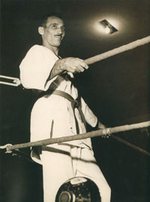
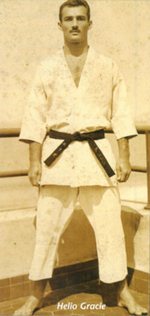
Carlson
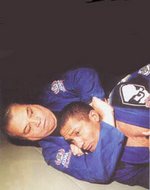
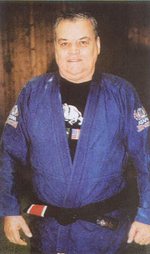
|
The younger brother of Carlos Helio (01/10/1913g-29/01/2009g) was very weak child. At the age of 14 he moved in with Carlos, who taught jiu-jutsu in Botafogo, a suburb of Rio. At first he just watched as his brother taught jiu-jutsu, as doctors advised him to refrain from any physical activity, including the exercises of jiu-jitsu. Once, when Helio was 16 years old, one of the disciples of Carlos came to the job, but the instructor was not there. Helio, remembering all the movements that showed his brother, proposed to begin training. When the training came to an end, Carlos showed up, apologizing for his absence. The students replied: "Everything is fine, I'm very pleased with working out with Helio. If you do not mind, next time I will continue training with him. "Carlos agreed. Thus by chance, Helio became a coach. He soon realized that the technique, which he watched during the lessons with Carlos, were not so simple in execution. In the relentless search for answers to their questions to improve the efficiency of jiu-jutsu, Helio decided to depart from the traditional technique, taught by his brothers. He began to change the movements, so that despite his weak body, he could still do them. Helio at an early age, watching Carlos and perceiving him not only as a brother, but his father, has strengthened the family tradition in the organization fights led by his older brother. Despite the fact that all of the Gracies were known as first-class fighters, Helio was distinguished, weighing 140 pounds (63.5 kg). He was the first idol in the sport in Brazil. His impressive fights, demonstrating bravery and courage, examplar impeccable technique and a particular style of life, made him an ideal symbol of hope for the entire nation. One day, the First Lady - Darcy Vargas, recognizing the enormous positive impact, invited Helio to the presidential palace and asked him to "save the Brazilian youth."
Helio saved a man, sinking in the Atlantic Ocean. For this he was awarded a medal of bravery. During his career, Helio only held 17 official fights, including the ones against the champions like Fred Ebert and Vladeck Zbysko. When Masahiko Kimura, the world champion in jiu-jitsu, came to Brazil, Helio had a chance to test his technique in the fight against the best athlete, and he challenged him. To everyone's surprise, a big-name champion refused, explaining his refusal to the difference in weight (about 80 lbs - 36,3 kg) and the fact that Helio was not a true jiu-jitsu fighter, thus, not a true oponent. Kimura proposed a duel with Kato, a second best fighter ju-jitsu in the world. He weighed 40 pounds (18.14 kg) more than Helio. Helio fought with Kato twice. The first fight was fought with a broken rib, this injury Helio received during a workout the prior week. Despite the serious risks and contraindications of doctors, Helio ended a fight in a draw. A month later, during the re-match, in front of astonished crowds Helio choked Kato, and he was unconscious for 6 minutes. This convincing victory put pressure on the great Kimura, who now had to defend the honor of Japan. The fight took place in Marokau, the biggest football stadium in the world. In the 13th minute, Kimura made his crown reception - "Kimura lock (ude-Garamy). Carlos, fearing that Helio will not give up and will get seriously injured, threw the towel, ending the fight with the Japanese champion. Kimura was so impressed by the Helio, that a day after the fight he came to the academy Gracie in Rio and invited Helio to study in Japan.
At the 42 years of age Helio had a duel against his best pupil 25-year Valdemar Santana. They met in battle, because Waldemar received a call from a soldier involved in the fake fights (wrestling, Katch - shows, pre-rehearsed, front fighting). Helio was against it. Valdemar said: "I must earn money, my family lives in poverty. If you give me some money, I will not agree to this fight. But if I do I bet, you can be sure that it will not be a catch, I intend to beat him. "Helio said:" If you go to this fight, I'll exclude you from the Academy. Santana still fought and won. After an "animated" conversation between two men, was organized by the battle. The fight lasted 3 hours 40 minutes, until Carlos threw in the towel, setting a world record for the duration of the fight without a break.
The whole country was so impressed by Helio courage in this fight, that his fame has increased, and the academy began to grow with new disciples, ready to share the teachings of his mentor. Later, when asked why he did not have time to prepare for this fight, he replied: "If you are attacked on the street, will you beg the attacker to wait 2 months until you get ready? Of course not. All my life I have taught weaker people to use methods of jiu-jutsu against stronger opponents at any time. How can I say one thing and act differently? "After the match, the eldest son of Carlos - Carlson, said to Valdemar, that even though he did not have anything personal aginst him, they needed to meet in the ring. They fought 6 times. Carlson has won 4 times, 2 times a draw.
Many years later, during one of the TV shows in Brazil, Helio was called to fight a master of Capuera. The fight was scheduled in a week. 55-year Helio insisted that the meeting took place immediately, than absolutely shocked younger and stronger opponent. The legacy of Helio Gracie and his brothers were continued by future generations. |
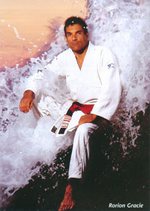
Rorion Gracie

Helio and Rorion

Helio and Rorion |
The older son of Helio - Rorion, had a Gi came before he learned to walk. At the age of two he had already spoken in public. At an early age he began studying jiu-jitsu under the guidance of his father. On the Christmas Eve 1969 Rorion came to the U.S. on vacation. After visiting relatives in New York and Washington, he moved to California, Los Angeles. After spending six months as America, Rorion returned to Brazil. In 1978, after divorcing his first wife and receiving a diploma at the State University of Rio de Janeiro, Rorion accepted the fundamental solution of his life existance - he returned to America and made the fighting style of his family known throughout the world. Rorion went to the Southern California and, thanks to his friends, got a job as an understudy in movies and TV shows. In addition, he covered his garage with and invited everyone to a free introductory lesson in jiu-jitsu. If they brought friends, they would always have the right to an additional free lesson, ten friends - ten free lessons, etc. Often came to him not so much students as instructors from other martial arts, who called Rorion to fights. To the surprise of the students and instructors, the style of Gracie has always been more effective. His fame grew with each passing day. Rorion re-married and had five children.
By the time his brother Royce, who came to America at 17, and engaged in teaching together with Rorion, helping him to adopt Gracie jiu-jitsu in the United States. Having contacts with Hollywood, Rorion was involved in staging fight scenes in movies, including "Lethal Weapon", where he worked with Mel Gibson and Rene Russo. Playboy magazine and the world's leading publication on martial arts helped spread and popularize the philosophy of Gracie Jiu-Jitsu, publishing articles on the Rorion's family and their style of fighting. In 1988, Rorion releases the first video course "Ju-Jitsu Gracie in Action", which demonstrated the advantages of this style. Training took place every day from 7 to 21, the number of students reached 120 people, 80 people were waiting for their turn. With the assistance of his brothers - Rickson, Royce, and Royler - the summer of 1989 Rorion opened the Academy of Gracie Jiu-Jutsu in Torrance, California. In 1993, Rorion and one of his students have developed the most revolutionary idea at that time, developments in the field of Martial Arts - The Ultimate Fighting Championship, UFC. (Fighting without rules in the "octagon").
Thanks to the creative thinking of another student, John Milius, they also created a unique scene - Octagon, although at that time Rickson was considered a champion of the family, Rorion chose Royce, as a family Gracie representative for fights in the Octagon. He believed that the lighter Royce will be an appropriate example of the potential of their family's style. Royce won multiple convincing victories at the championships in the Octagon. Later Royce Gracie became a four-time champion of the UFC. It should be pointed out that at that time, fights with no rules no weight categories and battles were fought without gloves.
In 1994, there was the Japanese version of the American Championship UFC started, called Pride, where the fighting is not in a cage, but in the ring. At these championships Rickson Gracie appeared, again becoming the champion (all matches were won by a "clean victory" judgement). Today, undisputable fact that if you really need to prepare to defend against a real street attack, a style of jiu-jutsu developed by the Gracie family is optimal choice.
In 2008, the sons of Rorion: Ryron and Rener created and organized the Gracie Combatives, the basic training program for teaching students from around the world and the training of highly qualified instructors. Certified centers are now opened around the world, except Russia. This question is curently being discussed with the Gracies by the leader of the Russian Gracie Jiu-Jitsu Garage - Dmitry Fomichev.
Key dates in the history of Gracie Jiu-Jitsu.
1925 - Carlos Gracie opened the first academy in Rio de Janeiro, Brazil.
1931 - Helio Gracie holds the first fight against heavyweight boxer Antonio Portugal and triumphs in a minute.
1947 - June 6, through a newspaper throws a challenge to the World Champion in professional boxing, Joe Louis (Joe Louis). The boxer's amnager rejected the call. To prove the effectiveness of his system Helio Gracie was ready to fight with anyone, anywhere, anytime. Since then, the concept became known as a "Gracie Challenge".
1951 - 23 October. Helio Gracie fights against Masashiko Kimura (Masashiko Kimura), the best fighter the Japanese Jiu-Jitsu. This was the only battle in the life of Helio Gracie, when he lost from the lock on the hand by Kimuro.
1978 - In summer, the oldest son of Helio Gracie, Rorion, left Brazil and moved to the USA, Southern California, where he opened the first Gracie Jiu-Jitsu Garage.
1980 - Rorion Gracie invites any fighter, any discipline regardless of the physical strength and size to fight against him. Since then he went on a triumphant march of Gracie Jiu-Jitsu in America.
1989г. - Rorion Gracie along with his brothers Rickson, Royce and Royler opened the first academy of Gracie Jiu-Jitsu in Torrance, California.
1993г. - November 12, Rorion Gracie started the UFC: Ultimate Fighting Championship.Royce Gracie represented the family in the championship, and became the first Champion of the UFC.
1994 The U.S. Army chose Gracie Jiu-Jitsu as the base-system for training soldiers. Particularly closely Gracie began to cooperate with the special units of the army and police.
2008 - Sons of Rorion Gracie, Ryron and Rener, developed a global training program, created certified centers worldwide. |
|
 Русский
Русский English
English  Русский
Русский English
English